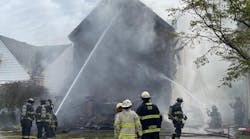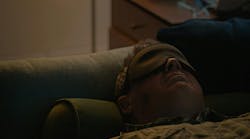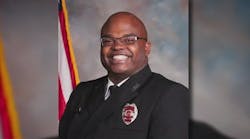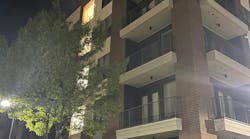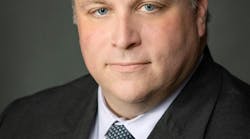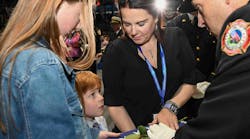This Close Call hits close to home, as it is the story of one of our own district chiefs (shift commander) at my department, the Loveland-Symmes Fire Department (LSFD), located in a suburb of Cincinnati.
Normally this column involves fireground response, operations and tactics, and while these things are important, the odds are that you won't directly experience many of those types of close calls. That's a good thing. On the other hand, odds are you or someone you work with will experience this type of close call—and we hope it is just that, a close call.
Our sincere thanks to the officers and members of the LSFD, the family of District Chief Jon Frye, whom this story is about; numerous southwest Ohio fire departments; the Firefighter Cancer Support Network (FCSN); the doctors, nurses and staff at The Jewish Hospital in Kenwood; the firefighters in the Disney World area of Florida; and so many others for their help in making this story possible.
District Chief Jon Frye’s perspective
July 20, 2014. I received the call I never expected. My white blood count was 1.8, and I needed to get to the emergency room ASAP. The past few weeks prior to this call I had been feeling fatigued and nauseated. The best I can explain is every step I took forward I felt like someone was pulling me back two steps. After two weeks of feeling like this, I called in sick to work for the first time in years.
I went to my family physician the next day for answers. I had just seen her in March for my annual physical, and everything checked out great. During this exam, my doctor couldn’t find anything out of the ordinary and ordered a bunch of blood tests. This being a Friday, I expected I would hear something on Monday. Sunday at noon my phone rings, and it is my physician’s cell phone. I didn’t think this would be good. She told me to get to an ER quickly.
I entered the ER, and they were waiting for me, as my doctor had called ahead. Immediately they started drawing blood, performing test to find out what was going on. My white blood count had already dropped to 1.4, which is dangerously low. They were checking for any kind of infection or virus that may be causing this. After being admitted for three days, they called in an oncologist who ordered a bone marrow biopsy.
On Wednesday, my fiancé Teresa and I were lying in my hospital bed and my cell phone rang—the second call I never expected. The words were simple: “Jon, I hate to do this over the phone, but we must get moving. You have leukemia and we need to transfer you to Jewish Hospital Kenwood to the blood cancer floor.”
Within seconds nurses and doctors were coming into my room to get things moving. They had a medical transport squad ready for me, but we decided Teresa would drive me over so we could gather our thoughts. Within 1 hour I was walking into my room at Jewish Kenwood Blood Cancer Center and being attended to by doctors, nurses and staff from OHC (Oncology Hematology Care), who are the reason I am able to share my story today.
As I lay in the bed and was prepped for a central line so they could get chemo started within 12 hours, I was told I would be in the hospital for at least 30 days to get my acute myeloid leukemia (AML) in remission, hopefully.
My life has completely done a 360 and I am no longer in control of my destiny. My family, my fire department and my close friends were already assembling at my bedside. One thing I did know was that I had nothing to worry about other than doing exactly what the doctors told me to do.
Loveland-Symmes Chief Otto Huber had already laid out a plan to ensure that I had someone at my bedside 24/7, my family was taken care of for meals, transportation or anything else they may need so Teresa could concentrate on getting me healthy. Over the next few hours, OHC was prepping me for the journey of a lifetime, and by nightfall Teresa and I had a few minutes alone to get our game plan together.
The first decision we made was not to ask why, not to look on the Internet and search for answers. We were already comfortable with Dr. Miguel Islas-Ohlmayer and the staff at OHC. My promise to Teresa was I was going to be ready for our wedding, which was already planned for March 24, 2015, at Disney World. The next morning I woke up to start chemotherapy, which would run for seven days straight, 24 hours a day.
Over the next 30 days, I spent my days and nights being attended to by some of the best in the business, from the nursing staff, doctors all the way to the cleaning staff. Everyone cared! The first 30 days I had visitors from all over, checking in to ensure that I was OK. We started our fight on July 23, 2014, as team FryeStrong, and are looking to make our name against cancer.
Two days into my fight, I received a call from Firefighter Steve Westcott (Ohio state director) from the FCSN. Steve lives in Cleveland and was currently winning his fight against AML. Steve wanted first and foremost to see how I was doing, and to let me know he was available to talk 24/7. He gave me his cell number and told me he was sending me some information from the FCSN.
Dr. Islas-Ohlmayer and his staff recommended starting to test my family for a bone marrow match if that was the course we decided to go with. I am the baby of five siblings. They started by testing my brother Kevin and sister Stephanie to see if we matched. The following week my brother called me and told me he was a 10 out of 10 on the bone marrow match chart. We were elated. The next day I was told my sister Stephanie was a 9 out of 10 match.
After 32 days, my cancer was in remission and I was ready to go home. At home I would receive two more rounds of chemo. It felt good to be home with my family and begin the next phase. I had daily visits to my oncologist, as they closely monitored me everyday. This is when I realized where this journey was taking me. I had a pillbox full of daily pills to keep me alive, and I had to ensure that I didn’t get contaminated or eat anything that could cause an infection, as my immune system was suppressed. Teresa had spent days prepping our house, cleaning, disinfecting and making things comfortable for me.
A “Command” decision
The time had come when I needed to make the decision on my future in the fight against AML. My choices were to complete three rounds of chemotherapy and hope to remain in remission or have a bone marrow transplant in the hopes that after 5 years I would be cured. This was the toughest decision of my life. I had many talks with doctors, nurses and others who have experienced both sides of the treatment.
Over the next few weeks, I pondered the pros and cons of the transplant, and finally took the best words of advice I could have received. My brother asked why would we leave anything on the table at this point; if this will possibly give me the best result, then this is what we should do.
My transplant was Oct. 6, 2014. I checked into the hospital seven days prior for my last chemotherapy treatment in preparation for the transplant. On Oct. 6, doctors took over 1,000cc of my brother’s bone marrow. I was waiting in my room as friends and family arrived to celebrate my new chance at life. Later that day, they arrived with Kevin’s bone marrow and started the transplant.
Over the next couple hours, I received the bone marrow while my friends and family gathered around. Soon after my brother came up from the recovery room and we were able to hug each other and be thankful for this moment. This hospital stay was about 24 days, and then I was able to go home where I was quarantined for the next 100 days.
The first few weeks, family members and fellow firefighters from work sat with me at home, as I couldn’t be unattended until I was able get some strength back. I went to my oncologist every day over the next 100 days to ensure that I was on track.
Over the next few months, my body was accepting the bone marrow and my numbers were rising. I found myself starting to come back, and I returned to work in March 2015. Most importantly, I was able to reach my main goal when this all started: Marry my beautiful fiancé Teresa on March 24, 2015, at the Disney Wedding Pavilion in front of 48 family and friends. In addition, there were some new friends—firefighters from Disney World's Reedy Creek, Orange County, Orlando, Winter Park fire departments, and others who showed up, in uniform, with equipment to honor my wife and I. Amazing.
The firefighter connection
As I look over the past year, I have learned so much about AML and how it relates to firefighters. What were my past practices in the past 23 years as a career firefighter? I am sure I had made some poor decisions on when to keep on my SCBA and protective gear. Early on in my diagnosis, I found out benzene was a major contributor to the cause of cancer, especially AML. Benzene is a colorless, flammable liquid with a sweet odor. Benzene is among the 20 most widely used chemicals in the United States. It is used mainly as a starting material in making other chemicals, including plastics, lubricants, rubbers, dyes, detergents, drugs and pesticides. In the past it was also commonly used as an industrial solvent and as a gasoline additive, but these uses have been greatly reduced in recent decades. Benzene is a natural part of crude oil and gasoline (and therefor motor vehicle exhaust), as well as cigarette smoke.
Reduce your exposure
We as firefighters must make every effort to reduce our exposure to these unknown chemicals and off-gases. We must always wear our PPE, SCBAs and monitor the air before we ever think about removing either of these. We must clean our fire gear routinely, and especially after every fire, to remove the carcinogens and other chemicals that are killing us. We must clean our bodies with wet wipes after exiting the structure and shower and put on a clean uniform once we arrive back at the station.
All this may seem like it’s overwhelming or too much, as we must always be prepared for the next fire. Well, you can’t be prepared if you’re laying in a hospital bed fighting for your life. We must not only train for our job but also educate ourselves and others of the inherent danger of our job. And we must take all the necessary steps to keep ourselves healthy so we can protect our communities.
I will leave you with these words:
- Never give up
- Take everyday like it’s your first day; we never will know enough.
- Train until your mind cannot withstand anymore and then arrive at your next shift and repeat.
- Take a look at your brother or sister who is kneeling next to you. Are they ready? Have they taken all the proper precautions before they enter the fire?
- The decisions we make today may affect the rest of our lives and our families’ lives. Be prepared to make the right decisions.
- When faced with adversity, take it head on. As firefighters, we took the oath to protect and serve our communities, but we can only do that when we take care of ourselves.
Next month
In Part 2 of this Close Call, we’ll offer accounts from LSFD Chief Otto Huber and Jon Frye’s wife, Teresa. Also, I’ll offer my own perspective on this unique Close Call, including 11 immediate actions you can take to protect yourself against carcinogen exposure. The actions are part of a Firefighter Cancer Support Network white paper called “Taking Action Against Cancer In The Fire Service.” The full white paper can be downloaded at http://tinyurl.com/WP-FCSN. FCSN is developing the second white paper in its occupational cancer series for release in 2016.

